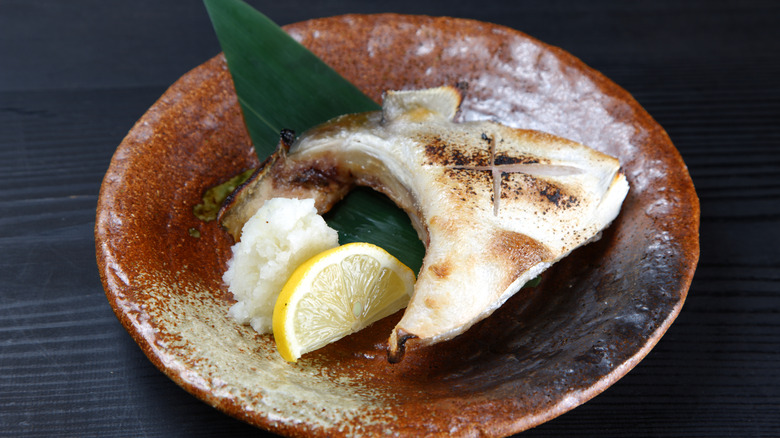Fatty Fish Collars Will End Your Hunt For Deliciously Inexpensive Fish Cuts
Fish sales in the U.S. are soaring — seafood was 2020's leading grocery growth sector with a 28.4% increase in sales (per FMI). However, this growth seems to have more to do with existing fish fans increasing their consumption rather than new people being converted to the cause. 44% of seafood buyers said that they grew more adept at cooking seafood during the pandemic, but 77% of customers still don't feel that they are knowledgeable enough about how best to prepare and cook seafood. Underwater life is so bizarre to us land dwellers that we both oversimplify and overcomplicate things, often to the cost of missing out on great food! As the QI elves observed, and BBC Wildlife confirmed, there really is no such thing as a fish. So there's no reason not to try and understand fish collars through a more familiar product — chicken, a.k.a. 'the tuna of the land.'
Before wings became ubiquitous, there were essentially only two types of chicken on menus — light, lean breast meat, and juicy, dark leg meat. It's the same with fish — you get the lean meat from the loins or fillets, and the juicier, fattier cuts like toro or otoro come from the belly (via Bradley Smoker).
Fish collars are crescent-shaped cuts that remain after you remove the head, belly, and fillets. Just like chicken wings, they're great for flavoring stocks and soups, but if that's all you're using them for, you are missing out on a cheap, sustainable source of sticky, unctuous, finger-licking goodness.
How to win your next BBQ with fish collars
Just like chicken wings, fish collars are meaty, but also bony. The trade-off for that is that the bones (and a good amount of fat and connective tissue) will keep the meat basting in its own internal juices, boosting the meaty flavor, and stopping the meat from drying out.
As Chef Epic points out, the fish collar contains a lot of vital nutrients that are lost when this part of the fish is tossed aside. The best way to extract these nutrients is by making some kind of broth. Frozen collars make excellent curries, per Oregon Live, and cooking them on the bone yields a velvetiness rare in fish curries.
Like chicken wings, many of the tastiest fish collar dishes involve the grill. Salon recommends a simple shioyaki-style salmon collar, grilled with oil, mirin, and salt. However, most preparations involve some kind of sauce to balance out the collar's fatty flesh. Glazes are a great way to go if you want to add sweetness, tang, or spice. Men's Journal suggests marinating collars in soy sauce, honey, and rice wine before giving them a quick grill, while chef Aaron London told Bon Appetit that cooks should brush on a sticky sauce halfway through grilling.
Marcus Samuelsson called fish collars "the spareribs of the sea" (via Epicurious). Like wings and ribs, cook them until the meat just comes off the bone, pair the finished product with something tangy, sticky, and spicy, and let the compliments roll in!

